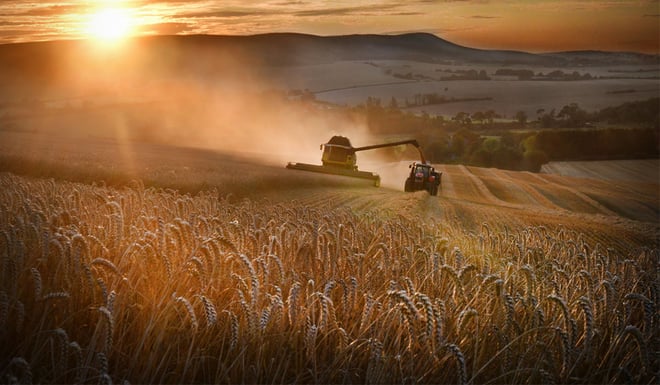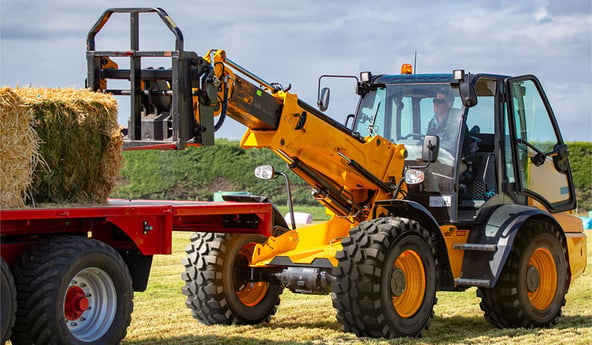All through the year we spend our time preserving the soil through a light soil preparation, optimising passages for seeding and the protection of crops by using low pressure tyres for the tractor, then the harvesting season comes along and we arrive with a combine harvester weighing 37,600 kilos with tyres inflated to 4 bar, with the intention of breaking the speed record to cover the entire field. It’s a bit like sending a bulldozer into a landscaped garden to clear the flowerbeds in 2 hours. The damage to the deep soil layers will be felt for many years. Yet there are real ways of saving time during the harvesting campaign, while obtaining a real bonus load without ever exceeding 2.4 bar.
You will find all the explanations you need in this article.
1. Do my combine harvester tyres really have an impact on the soil?
Harvesting is one of the “heavy duty” campaigns which will have a major impact on the soil in your fields, with the size and weight of the harvesting machinery increasing constantly.
- Integral harvesters during the beetroot harvest certainly have the greatest impact on the soil, in addition to the combination vehicle which follows them, often during the wet season.
- Forage harvesters accompanied by their tractor-trailer combination also have a major impact on the soil.
- Combine harvesters have the advantage of being used more frequently in summer, when the weather conditions are normally more dry, although this does nothing to limit the load.
The average tare weight of a combine harvester is 20 tonnes, and with the cutting platform, the total weight can be more than 24 tonnes. Depending on the model, the grain tank can contain between 8,000 and 15,000 liters which, according to the density of the grain, gives a load capacity of between 6,700 kg and 12,600 kg.
If you take into account the very high load distribution on the front axle linked to the cutting platform, with a distribution of 75% of the weight to the front and 25% to the rear, you obtain a load (full grain tank) of around 28,000 kg on the front axle and 9,600 kg on the rear axle, i.e. a total of 37,600 kg.
The impact on the soil of your field is therefore considerable, especially if you add the tractor/trailer combination vehicles to unload the grain tank.
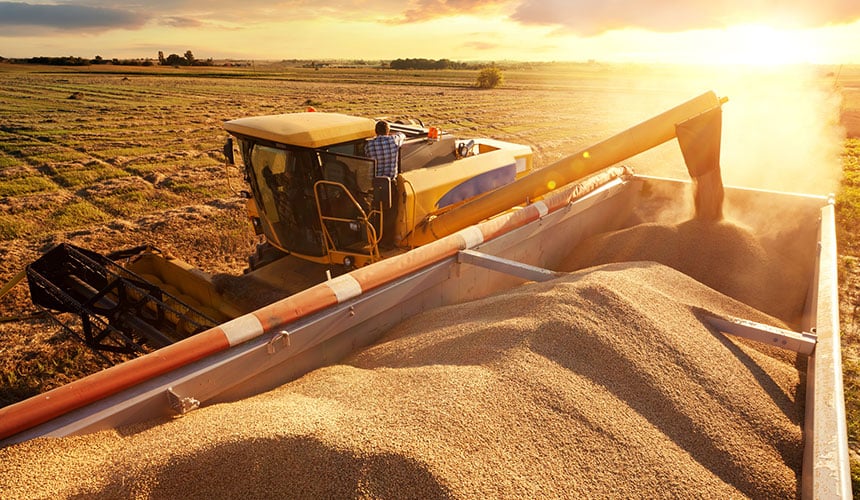
2. What is the impact of a standard tyre on my soil with a bonus load
The role of the tyre is crucial during harvesting campaigns, as it’s the tyre that is in contact with the ground and which exerts a more or less high mechanical pressure depending on the mass and inflation pressure. As indicated above, to bear around 28,000 kg on the front axle, i.e. a load of 14,000 kg per tyre on the front axle, it is necessary to increase inflation pressure.
To simplify things, we consider that the inflation pressure corresponds to the pressure applied to the ground, so if you increase pressure to 4 bar, you will really compact the soil in depth which will lead to a loss of yields during the following years of 5 to 30% depending on the type of soil and the weather conditions during the days prior to the harvest.
Yet you are short of time and too dependant on weather conditions to worry about soil compaction at this strategic point in time, so having a bonus load means saving time and continuing to work between trailer trips back and forth.
Bonus load with standard harvesting tyres
The harvester tyre offers a bonus load in certain very precise conditions. To increase the load, you must reduce speed as much as possible and increase inflation pressure.
To obtain: 55% bonus load
- You must reduce speed to 15 km/h.
- Increase pressure by 25% (often the tyre manufacturer’s user manual recommends 3.2 bar which has to be increased to 4 bar during cyclical harvesting operations).
- The slope must not be greater than 20% (11 degrees).
- At maximum capacity, the tyre must not travel more than 1.5 km.
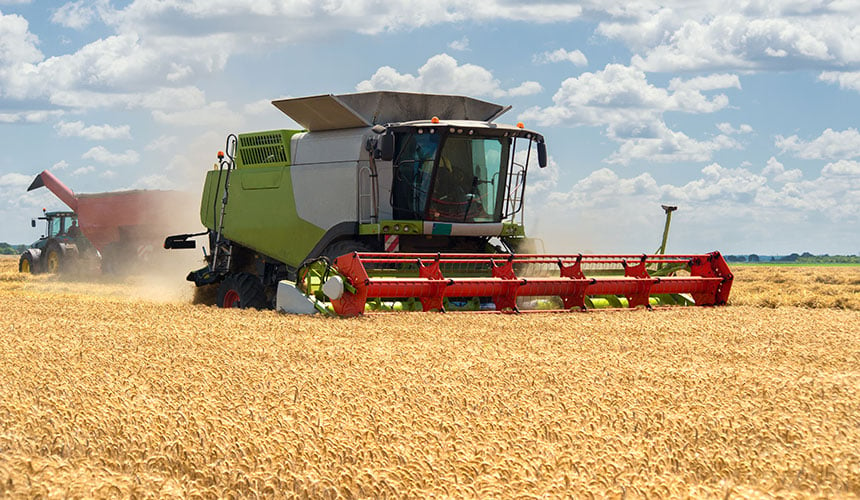 Bonus load between trailer rotations
Bonus load between trailer rotations
3. The CFO tyre specially designed to bear more load
The CFO harvester tyre is specially designed for harvesting campaigns, also known as cyclic field operations (CFO). The stress faced by the tyre during harvesting is the result of major fluctuations during the repeated loading and unloading of the grain tank. The difference in weight on the tyres is more or less 12,000 kg depending on the type of machine.
This specific category of harvester tyre is very different from a standard tractor tyre. The tractor needs high drive torque whereas the harvester needs to carry more weight with less torque.
These tyres have a more elaborate casing construction technology, making it more robust than standard agricultural tyres. It’s what allows them to bear a bonus load, but to bear such a difference in weight, it is imperative to respect certain conditions of use:
Load and pressure:
The link between load and pressure is quite obvious, the weight squashing the tyre. It’s the air pressure within the tyre which makes it possible to compensate for this squashing effect and to avoid excess deformation. It is therefore necessary to increase pressure in order to increase the load.
Load and speed:
The link between speed and load is less obvious, the increase in load making it necessary to reduce speed, for a simple reason, which is that speed increases the deflection and internal heating of the tyre. You have noticed that the area of the tyre in contact with the ground changes form, it is flattened into the ground.
When the wheel turns round once, this area regains its initial form until it is in contact with the ground again and flattened once more, which is what we call deflection.
When you accelerate, the number of wheel rotations per second increases and deflections get closer until there is too much deformation of the tyre. So to benefit from an additional bonus load you must reduce speed.
To obtain: 70% bonus load
- You must reduce speed to 10 km/h
- Increase pressure to 4 bar.
- The slope must not exceed 20% (11 degrees).
- At maximum capacity, the tyre must not travel more than 1.5 km.
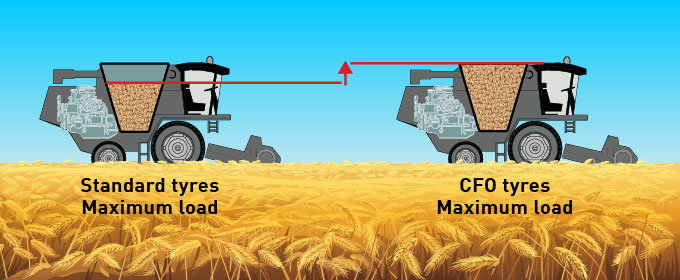
Bigger bonus load for CFO tyres
4. More high-tech tyres for a bonus load without compaction
Certain more high-tech harvester tyres are made to CFO (Cyclic Field Operations) standards as well as IF and VF standards for greater flexion capacity. The reinforced casing is more robust and higher quality materials guarantee greater resistance and a greater flexion/deflection variation potential. This highly specific capacity makes it possible to increase the load without increasing inflation pressure. The tyre footprint is 22% larger than standard tyres which is good for the protection of the soil in your fields.
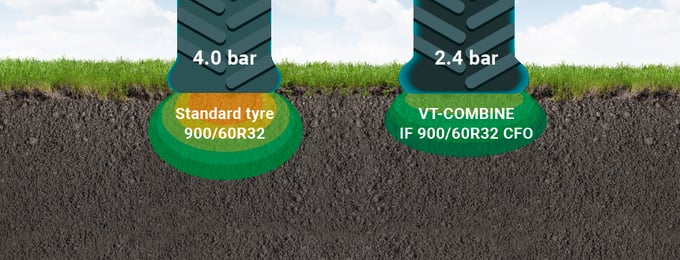
Comparison of the soil impact of
the VT-Combine compared to a standard tyre
Higher bonus load in all circumstances
More than a simple temporary bonus, it’s the chance to increase the efficiency of your combine harvester. With IF CFO front tyres for a maximum bonus load and VF CFO rear tyres to bear more load on the road when the cutting platform is not mounted, you will be able to optimise every step of your work.
A speed of 15 km/h despite maximum load
As well as being perfectly adapted to sloping land, VF-Combine IF and VF CFO tyres allow you to keep a moderate pressure of 2.4 bar whatever the load, which is a major advantage, in addition to being able to maintain a speed of 15 km/h.
With VT-Combine IF and VF CFO tyres can obtain: 86% bonus load
- You must reduce speed to 15 km/h
- Maintain pressure at 2.4 bar.
- The slope must not exceed 20% (11 degrees).
- At maximum capacity, the tyre must not travel more than 1.5 km.
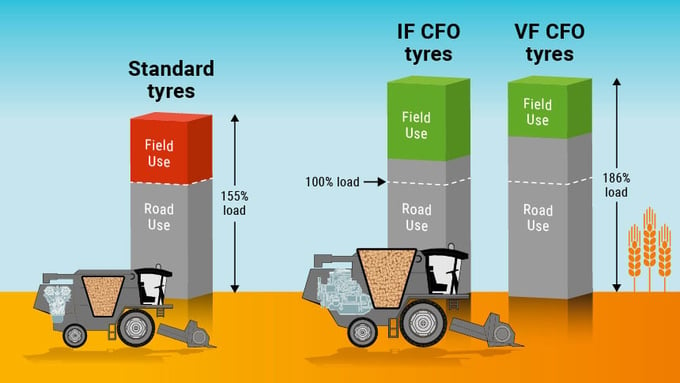
Comparison of the bonus load with IF, VF CFO tyres
The tyre therefore plays a major role in your harvesting campaign when every minute counts. A more high-tech tyre allows you to save time with a much higher bonus load while preserving your soil.
Avoiding compaction without losing time is the guarantee of a successful harvest, without affecting future yields.
The Bridgestone-agriculture.eu blog is written and administered by tractor tyre experts who are available to provide you with the advice you need on the subject of your agricultural tyres. They allow you to maximise your productivity with information on all subjects linked to tyres: Technical data for agricultural tyres – Agricultural tyre performance – Air pressure advice, Solutions to avoid soil compaction – Sprayer tyre pressure – Why and how to ballast your tractor tyres – etc….
To take it one step further and increase the profitability of your farm, les Experts du pneu provide a free, highly detailed eBook which explains the essential role of the agricultural tyre in your productivity.
Most people who read this article have also read some of the following articles which are listed by order of popularity:
- Buying guide: 10 important tips for choosing the right farming tyres
- 4000 euros in savings per year by chosing a better agricultural tyre
- How to choose tyres for my farm trailer before the harvest?
- Standard farming tyre or forestry tractor tyre for deforestation?
- Which is better value? A cheap agricultural tyre or a VF tractor tyre
- Here’s how your agricultural tyres can save you money
- How to make the right choice for your agricultural or tractor tyres?
- Increase the yield of your sprayer with narrow VF tyres
- Do you know which are the best agricultural tyres for your sprayer?
- A good agricultural tyre is the best guarantee of sprayer stability
- What is the best tyre for my combine harvester, IF, VF or CFO?
- A hi-tech agricultural tyre to save time during your harvest
- The top 5 reasons for choosing VF agricultural tyres
- The VF agricultural tyre: VF technology increases your productivity
- Cheap agricultural tyres, discount agricultural tyres, is it worth it?
This information is intended only to make you aware of the technical and functional aspects of agricultural tires and their use. It does not allow you to make a judgment or a definitive conclusion on a given problem. Only your agricultural tire expert is able to make a technical assessment and take a final decision, case by case.
Leave a
commentary
Your email address will not be published.
Required fields are indicated with *


